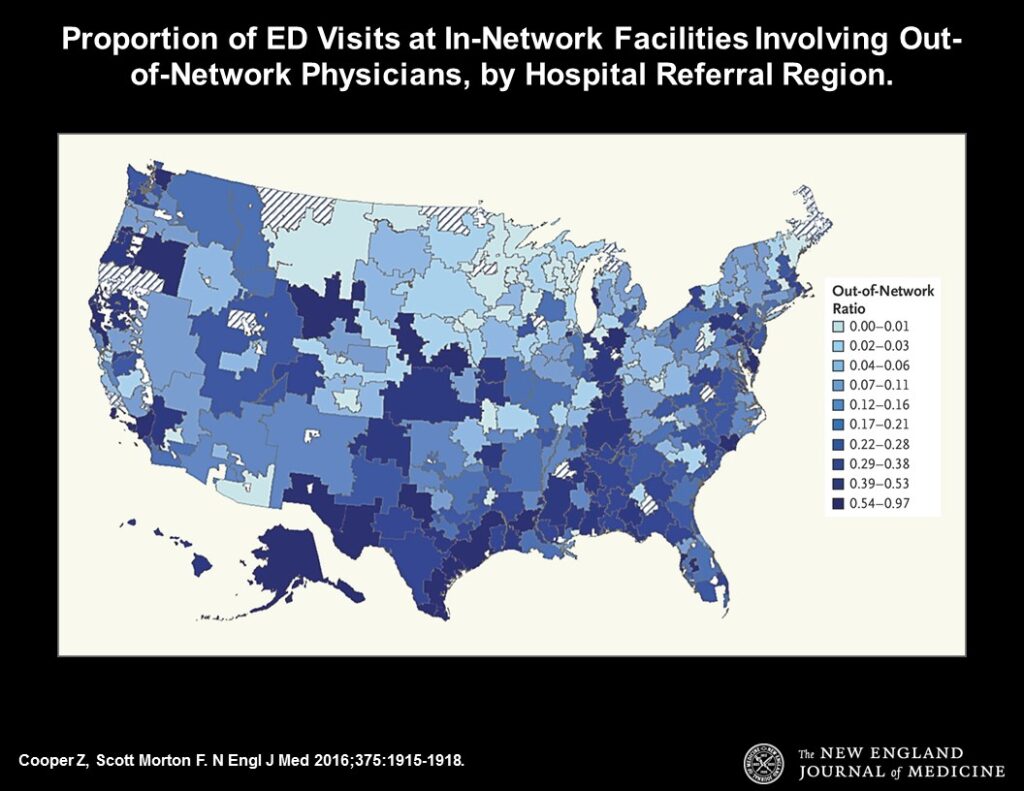What’s the latest in health policy research? The Essential Scan, produced by the Schaeffer Initiative for Innovation in Health Policy, aims to help keep you informed on the latest research and what it means for policymakers.
22% of emergency room visits at in-network facilities nationwide involved an out-of-network physician, leaving patients with large surprise bills
Zack Cooper and Fiona Scott Morton, in the New England Journal of Medicine, find a startling 22 percent of in-network emergency room visits nationwide involve an out-of-network physician (though with wide variation throughout the country), highlighting the presence of surprise balance billing in a setting where it is unreasonable to expect patients to avoid out-of-network ED physicians. Patients are hit with large surprise medical bills due to the doctor “balance billing” significantly beyond what the insurer pays. The study finds that out-of-network emergency physicians charge an average 798 percent of Medicare rates, far more than the already high 297 percent of Medicare rates that in-network ED doctors receive, on average. The article argues solving the problem would require hospitals to sell a bundled ED care package. Researchers with the Brookings-USC Schaeffer Initiative also recently laid out a series of federal policy solutions to put an end to surprise medical bills. NEJM article here and Schaeffer Initiative paper here.
These situations where patients lack the ability to choose a provider are outside the influence of market forces and regulation. The enormous geographic variation is testimony to the need to develop market or regulatory mechanisms to achieve fair payment rates.”
-Paul Ginsburg, PhD, Director of the Schaeffer Initiative
Public spending on non-health services like fire protection, education, and libraries are associated with improved population health
Mac McCullough and Jonathon P. Leider find spending in seven of fourteen expenditure categories examined including fire protection, K–12 education, correctional facilities, and libraries is associated with improvement in county health outcome rankings. Yet, some of these same categories of public spending experienced diminishing returns when spending increased significantly. Using both the public expenditure data from 2008 to 2012 and County Health Ranking data from 2010 – 2015, the authors analyzed the association between public spending in 14 key social services and population health measures including age and quality of life. These findings add to the body of evidence linking social determinants and health, denoting the particular categories of non-health spending that policymakers could seek to leverage to improve the health population health through the positive externalities of those services. Full article here.
New analysis finds beneficiaries “retime” care more than previously thought
Haizhen Lin and Daniel W. Sacks find that beneficiaries are nearly twice as sensitive to short-term price changes like hitting the deductible as they are to long-term changes in benefit design. The authors used data from the RAND Health Insurance Experiment (1971 – 1986), which assigned people at random either to a free plan with no out-of-pocket expenses or to a plan with coinsurance up to a certain maximum out-of-pocket amount. Average monthly per beneficiary spending was approximately one third lower for individuals with coinsurance than for those with free coverage. However, when beneficiaries with coinsurance hit their maximum dollar expenditure, their spending increased substantially, suggesting a “retiming” of services including planned procedures, well-care visits, and dental care. As the amount and prevalence of high deductible health plans increase, these findings become increasingly important to public and private payers grappling with how to control costs while promoting health, as well as underscore the need for updated research on the topic. Full article here.
Health information technology and provider integration independently improve adherence to guidelines, magnitude diminished when combined
Jordan Everson, Shoou-Yih Daniel Lee, and Julia Adler-Milstein find that health information technology (HIT) adoption and hospital-provider integration are each independently associated with improved adherence to evidence-based practices (EBPs) but have an “offsetting” effect when combined. Specifically, they found that tightly integrated hospital-physician systems saw a substantially smaller increase in adherence to EBPs when fully adopting HIT (5.9 percent of standard deviation) than did systems that were not integrated (41.8 percent of standard deviation). The authors used data from the American Hospital Association’s Annual and IT Supplement surveys, as well as the Centers for Medicare and Medicaid Services’ Hospital Compare, to analyze the independent and combined impact of these methods of performance improvement. With these findings, policymakers may want to target future incentives for HIT adoption or other practice improvement methods on practice settings not already employing their own improvement strategies. Full article here.
Click here to receive The Essential Scan email.
